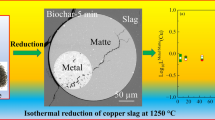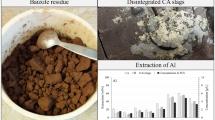Abstract
Ausmelt technology opens up new opportunities for the economic processing of complex copper smelter dusts. Not only can the technology separate more of the unwanted elements to produce a clean blister copper for refining, but it can also allow production of fume and precious metal products that can be readily upgraded to produce high-grade, valuable products. Developments in the processing of copper-bismuth-gold flue dusts left over after the smelting of bismuth-bearing concentrates in flash furnaces are described, including pilot-plant trials and process and equipment development. Design considerations and capital and operating costs for the proposed plant are discussed.
Similar content being viewed by others
References
J.M. Floyd and B.W. Lightfoot, “The Wide World of Sirosmeit,” Engineering Mining Journal, 186(6) (1985), pp. 52–56.
J.A. Vogt, P.J. Mackay, and G.C. Balfour, “Current Converter Practice at the Horne Smelter,” Copper and Nickel Converters (Warrendale, PA: TMS, 1979), pp. 357–390.
K. Itagaki, “Thermodynamic Evaluation of Distribution Behaviour of V-A Elements and Effect of the Use of Oxygen in Copper Smelting,” Metallurgical Review of MMIJ, 3 (3) (1987), p. 87.
Author information
Authors and Affiliations
Rights and permissions
About this article
Cite this article
Swayn, G.P., Robilliard, K.R. & Floyd, J.M. Applying Ausmelt processing to complex copper smelter dusts. JOM 45, 35–38 (1993). https://doi.org/10.1007/BF03222403
Issue Date:
DOI: https://doi.org/10.1007/BF03222403




